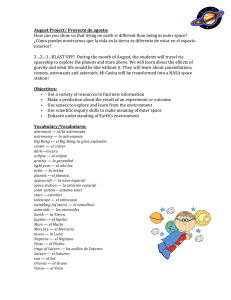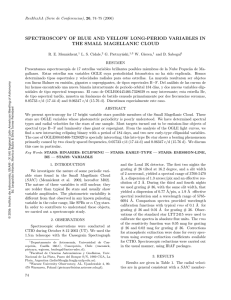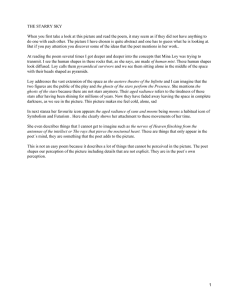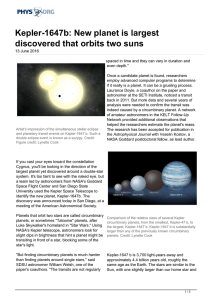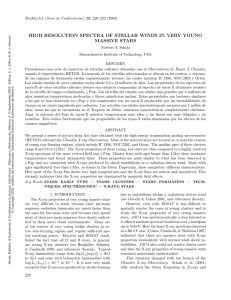Metallicity trends in solar–type stars with debris discs and planets
Anuncio
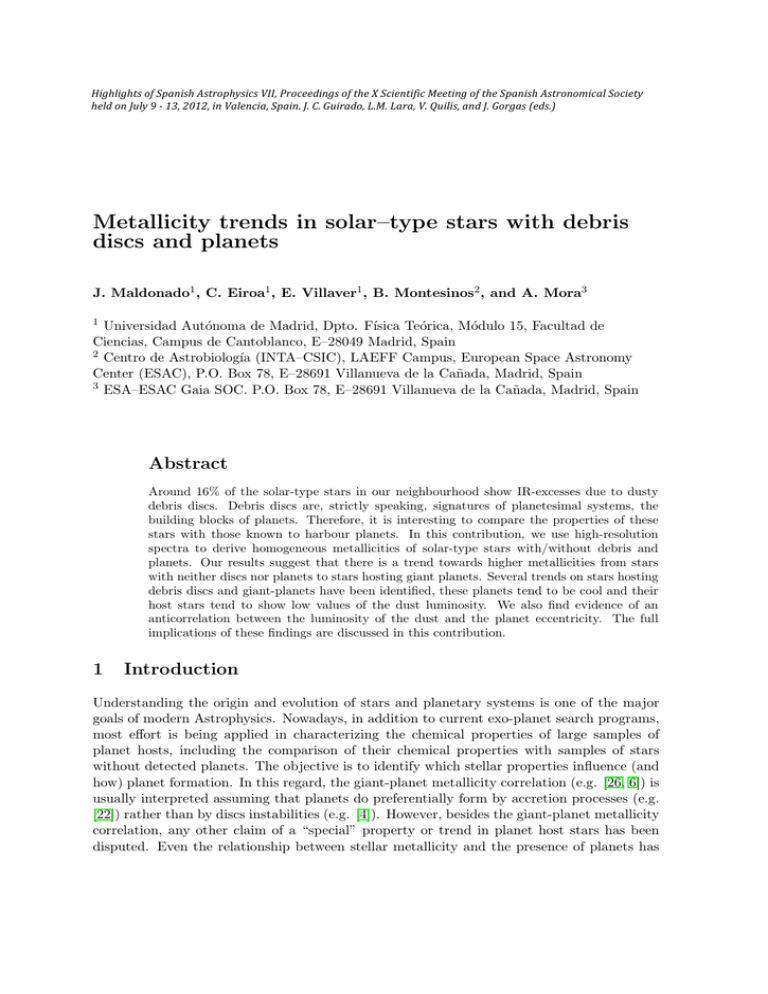
Highlights of Spanish Astrophysics VII, Proceedings of the X Scientific Meeting of the Spanish Astronomical Society held on July 9 -­‐ 13, 2012, in Valencia, Spain. J. C. Guirado, L.M. Lara, V. Quilis, and J. Gorgas (eds.) Metallicity trends in solar–type stars with debris discs and planets J. Maldonado1 , C. Eiroa1 , E. Villaver1 , B. Montesinos2 , and A. Mora3 1 Universidad Autónoma de Madrid, Dpto. Fı́sica Teórica, Módulo 15, Facultad de Ciencias, Campus de Cantoblanco, E–28049 Madrid, Spain 2 Centro de Astrobiologı́a (INTA–CSIC), LAEFF Campus, European Space Astronomy Center (ESAC), P.O. Box 78, E–28691 Villanueva de la Cañada, Madrid, Spain 3 ESA–ESAC Gaia SOC. P.O. Box 78, E–28691 Villanueva de la Cañada, Madrid, Spain Abstract Around 16% of the solar-type stars in our neighbourhood show IR-excesses due to dusty debris discs. Debris discs are, strictly speaking, signatures of planetesimal systems, the building blocks of planets. Therefore, it is interesting to compare the properties of these stars with those known to harbour planets. In this contribution, we use high-resolution spectra to derive homogeneous metallicities of solar-type stars with/without debris and planets. Our results suggest that there is a trend towards higher metallicities from stars with neither discs nor planets to stars hosting giant planets. Several trends on stars hosting debris discs and giant-planets have been identified, these planets tend to be cool and their host stars tend to show low values of the dust luminosity. We also find evidence of an anticorrelation between the luminosity of the dust and the planet eccentricity. The full implications of these findings are discussed in this contribution. 1 Introduction Understanding the origin and evolution of stars and planetary systems is one of the major goals of modern Astrophysics. Nowadays, in addition to current exo-planet search programs, most effort is being applied in characterizing the chemical properties of large samples of planet hosts, including the comparison of their chemical properties with samples of stars without detected planets. The objective is to identify which stellar properties influence (and how) planet formation. In this regard, the giant-planet metallicity correlation (e.g. [26, 6]) is usually interpreted assuming that planets do preferentially form by accretion processes (e.g. [22]) rather than by discs instabilities (e.g. [4]). However, besides the giant-planet metallicity correlation, any other claim of a “special” property or trend in planet host stars has been disputed. Even the relationship between stellar metallicity and the presence of planets has 714 Metallicity trends in solar-type stars with debris discs and planets revealed to be more complex than previously thought, as several groups of host stars do not tend to be preferentially metal rich, namely, stars hosting low-mass planets, Mp < 30M⊕ , [31, 27, 28, 7, 16, 5], and evolved (subgiants and red-giant) stars with planets [21, 8]. Around 16% of the main-sequence solar-type (spectral types F5 to K5) stars are known to show an infrared excess at Spitzer-MIPS 70 µm due to the presence of a dusty circumstellar disc [30]. These discs, usually known as debris discs, are composed by a second generation dust continuously replenished by the attrition of larger bodies [1]. Strictly speaking, debris discs constitute signatures of planetesimal systems, i.e., the raw material from which planets are formed, so a relationship between the presence of planets and debris discs should be expected. However, the incidence of debris discs around stars with planets is comparable to the incidence around non planet hosts [13] and previous results do not find any correlation between the presence of debris discs and the stellar metallicity, or other characteristics of the stars with planets [2, 10, 19, 25, 3, 13]. Since these works, new debris discs and planets have been discovered, in particular low-mass planets, reaching now objects with masses as low as only few times the Earth’s mass. The number of stars harbouring debris discs and planets has increased by ∼ 50% with respect to the latest works. In this contribution we review the properties of the stars with debris discs and planets in order to determine whether these stars follow any special trend in their properties, setting the results in the context of debris discs and planets formation. 2 Stellar samples and methodology In a recent work, [14] revisit the analysis of the properties of solar-type stars hosting debris discs and/or planets. Four samples of stars are considered: 1. A sample of stars with known dusty debris discs (SWDs): It contains 107 stars with known debris discs discovered by the IRAS, ISO, and Spitzer satellites. 2. A sample of stars with known debris discs and planets (SWDPs): It lists 29 solar-type stars with debris discs and planets. 3. A sample of 120 stars hosting exclusively giant planets (SWPs): from [26, 32, 28, 16, 32], where stars with retracted or not-confirmed exoplanets were removed. 4. A comparison sample (SWODs): 145 stars in which IR-excesses were not found at Spitzer-MIPS wavelengths. The metallicity distribution of the SWD, SWOD, and SWDP samples are constructed following a two-steps procedure: • Homogeneous analysis: In a first step, homogeneous metallicities are determined from high-resolution (R ∼ 57000) échelle spectra obtained in 2 − 3 meters class telescopes [15, 14]. Metallicities are obtained by using the code TGV [29] which is based on the iron ionisation and excitation equilibrium conditions. This homogeneous analysis covers the 33% and 40% of the whole SWD and SWOD samples. J. Maldonado et al. 715 • Full samples analysis: The spectroscopic observations performed in [15] were limited to 25 pc, therefore data from the literature is needed to cover the full SWD and SWOD samples. In order to keep the metallicities as homogeneous as possible, the stars in common with [20, 32] were used to set literature values into our own metallicity scale. A detailed analysis of the properties of the SWDP sample reveals some interesting trends. First, we note that SWDPs tend to have a high incidence of multiplanet systems, likely to a rate close to the one of stars with low-mass planets. Many of them are found to harbour low-mass planets. Furthermore, in the cases with only gas-giant planets, these planets tend to be cool-distant Jupiters (a > 0.1 AU)1 . 3 Metallicity distributions Figure 1 compares the cumulative metallicity distributions of the different samples. First, we note hat the distribution of SWDs is similar to that of SWODs, although the distribution of SWDs seems to be slightly shifted towards higher metallicities. In addition, there seems to be a deficit of stars with discs at low metallicities (below approximately −0.1 dex). The distribution of SWDPs can be clearly distinguished from that of SWDs and is similar to that of SWPs, a behaviour which is irrespective of whether the planets are low-mass or giant planets. Therefore, it is the presence of planets, and not debris discs, which correlates with the stellar metallicity. The SWP sample is divided into hot and cool Jupiters. The data suggests that the frequency of hot giant planets is lower for low metallicities than the frequency of cool ones. These trends can be explained with core-accretion models [22, 11, 12, 18, 17] and are consistent with the view that the mass of solids in protoplanetary discs is the main factor in determining the outcome of a system [9, 19]. 4 Trends with the fractional dust luminosity Figure 2 shows the fractional dust luminosity, Ldust /L? , versus the stellar metallicity (left). The figure distinguishes between gas-giants and low-mass planets. It is found that most of stars hosting debris discs and cool giant planets tend to have low dust luminosities, Ldust /L? < 10−4 ; indeed more than 50% of SWDPs of this type are concentrated in the low-dust luminosity/high metallicity corner of the Figure. This trend is not seen in stars with lowmass planets. In addition, we find evidence of an anticorrelation between the fractional dust luminosity and the eccentricity of the innermost planet (Fig. 2, right panel), albeit a significant scatter. This kind of anticorrelation could be explained as the result of dynamical instabilities produced by eccentric giant planets, which clear out the inner and outer regions of the planetary discs [24, 23] On the other hand, there is no trend with other planetary properties, although it seems that low-mass planets tend to be predominantly hot. 1 The SWD, SWOD, and SWDP samples are listed in [14], Tables 1, and 7, while the estimated stellar parameters and iron abundances from the homogeneous analysis are given Table 5. These tables are available in electronic format at the CDS, http:\cdsarc.u-strasbg.fr/viz-bin/qcat?J/A+A/541/A40. 716 Metallicity trends in solar-type stars with debris discs and planets Figure 1: Histogram of cumulative frequencies of samples of SWODs, SWDs, SWDPs, and SWPs. Figure from [14]. 5 Summary The number of debris discs stars known to host planets, has increased in the past few years ∼ 50%, particularly those associated with low–mass planet. In [14] the properties of these stars have been revisited, and compared with the properties of stars with planets, stars with debris discs, and stars with neither debris nor planets. The analysis of the metallicity distribution of the different samples shows a smooth transition towards higher metallicities, from stars with neither debris discs nor planets to stars hosting gaseous hot-Jupiters. In particular, stars with and without debris discs show similar distributions, although that of the former seems to be slightly shifted towards higher metallicity values. Stars harbouring both debris discs and planets behave in the same way as the distribution of those stars hosting giant planets. These results support the scenario of core accretion for planet formation. In addition, it is found that debris discs stars hosting cool giant planets tend to have the lowest dust luminosities, and that there seems to be an anticorrelation between the dust luminosity and the innermost planet eccentricity; trends which can be explained by recent simulations of dynamical instabilities produced by eccentric giant planets. The trends suggested in this work will be likely confirmed or rejected by the ongoing Herschel programmes J. Maldonado et al. 717 Figure 2: Left panel: Fractional dust luminosity, Ldust /L? , versus stellar [Fe/H] for those stars hosting a debris disc. Right panel: Fractional dust luminosity, Ldust /L? , versus the eccentricity of the innermost planet for those stars harbouring simultaneously debris discs and planets. Figures from [14]. dealing with planets and debris discs, together with the expected detection of further planets. Acknowledgments This work was supported by the Spanish Ministerio de Ciencia e Innovación (MICINN), Plan Nacional de Astronomı́a y Astrofı́sica, under grant AYA2008–01727. J.M. acknowledges support from the Universidad Autónoma de Madrid (Department of Theoretical Physics). References [1] Backman, D. E. & Paresce, F. 1993, Protostars and Planets III, 1253 [2] Beichman, C. A., Bryden, G., Rieke, G. H., et al. 2005, ApJ, 622, 1160 [3] Bryden, G., Beichman, C. A., Carpenter, J. M., et al. 2009, ApJ, 705, 1226 [4] Boss, A. P. 1997, Science, 276, 1836 [5] Buchhave, L. A., Latham, D. W., Johansen, A., et al. 2012, Nature, 486, 375 718 Metallicity trends in solar-type stars with debris discs and planets [6] Fischer, D. A. & Valenti, J. 2005, ApJ, 622, 1102 [7] Ghezzi, L., Cunha, K., Smith, V. V., et al. 2010, ApJ, 720, 1290 [8] Ghezzi, L., Cunha, K., Schuler, S. C., & Smith, V. V. 2010, ApJ, 725, 721 [9] Greaves, J. S., Fischer, D. A., Wyatt, M. C., Beichman, C. A., & Bryden, G. 2007, MNRAS, 378, L1 [10] Greaves, J. S., Fischer, D. A., & Wyatt, M. C. 2006, MNRAS, 366, 283 [11] Ida, S. & Lin, D. N. C. 2004, ApJ, 616, 567 [12] Hubickyj, O., Bodenheimer, P., & Lissauer, J. J. 2005, Icarus, 179, 415 [13] Kóspál, Á., Ardila, D. R., Moór, A., & Ábrahám, P. 2009, ApJ, 700, L73 [14] Maldonado, J., Eiroa, C., Villaver, E., Montesinos, B., & Mora, A. 2012, A&A, 541, A40 [15] Maldonado, J., Martı́nez-Arnáiz, R. M., Eiroa, C., Montes, D., & Montesinos, B. 2010, A&A, 521, A1 [16] Mayor, M., Marmier, M., Lovis, C., et al. 2011, arXiv:1109.2497 [17] Mordasini, C., Alibert, Y., Benz, W., Klahr, H., & Henning, T. 2012, A&A, 541, A97 [18] Mordasini, C., Alibert, Y., & Benz, W. 2009, A&A, 501, 1139 [19] Moro-Martı́n, A., Carpenter, J. M., Meyer, M. R., et al. 2007, ApJ, 658, 1312 [20] Nordström, B., Mayor, M., Andersen, J., et al. 2004, A&A, 418, 989 [21] Pasquini, L., Döllinger, M. P., Weiss, A., et al. 2007, A&A, 473, 979 [22] Pollack, J. B., Hubickyj, O., Bodenheimer, P., et al. 1996, Icarus, 124, 62 [23] Raymond, S. N., Armitage, P. J., Moro-Martı́n, A., et al. 2012, A&A, 541, A11 [24] Raymond, S. N., Armitage, P. J., Moro-Martı́n, A., et al. 2011, IAU Symposium, 276, 82 [25] Saffe, C., Gómez, M., Pintado, O., & González, E. 2008, A&A, 490, 297 [26] Santos, N. C., Israelian, G., & Mayor, M. 2004, A&A, 415, 1153 [27] Sousa, S. G., Santos, N. C., Mayor, M., et al. 2008, A&A, 487, 373 [28] Sousa, S. G., Santos, N. C., Israelian, G., et al. 2011, A&A, 526, A99 [29] Takeda, Y., Ohkubo, M., & Sadakane, K. 2002, PASJ, 54, 451 [30] Trilling, D. E., Bryden, G., Beichman, C. A., et al. 2008, ApJ, 674, 1086 [31] Udry, S., Mayor, M., Benz, W., et al. 2006, A&A, 447, 361 [32] Valenti, J. A. & Fischer, D. A. 2005, ApJS, 159, 141
